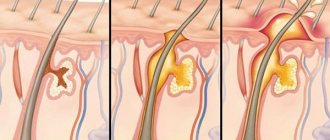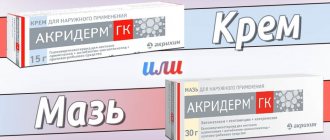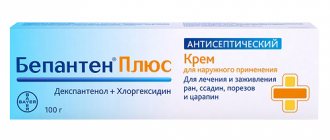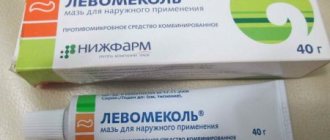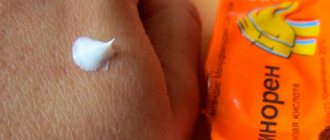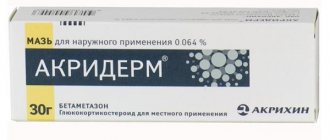Diseases of fungal etiology are extremely unpleasant ailments that affect not only nails and skin, but also the internal organs of a person. Pathogenic infections are accompanied by increasing itching, skin rash, cracks in the epidermis and an unpleasant odor. They cause the patient a lot of discomfort.
To combat them, a wide range of antifungal agents are used, one of which is Clotrimazole. It is used to treat most dermatological pathologies, including the treatment of vaginal diseases. But not everyone knows what is better - Clotrimazole ointment or cream, and in which cases it is preferable to use one or another form of medication. We will devote today’s article to this issue.
general description
CLOTRIMAZOLE has an antifungal and antibacterial effect on a wide range of pathogenic microorganisms.
It destroys cell membranes and penetrates them, destroying the life-supporting systems of fungi and their spores.
How does it act on pathogenic microorganisms?
Thanks to the action of the drug, the speed of oxidative enzymes in the affected cells is reduced to a minimum, and the level of hydrogen peroxide concentration increases. As a result of intoxication, the body of the parasitic cell is destroyed and the cell itself dies.
CLOTRIMAZOLE, in addition to fighting growing and dividing microorganisms, also has a protective effect, preventing new infections from entering the body.
The drug is highly effective against damage to the body by strains of the most common fungi.
Spectrum of action
CLOTRIMAZOLE is indicated for the destruction of fungi:
- Candida albicans (thrush)
- Candida spp. (candidiasis) and other genus Candida
- Trichophyton mentagrophytes, Microsporum canis, Epidermophyton floccosum, Trichophyton rubrum, Malassezia furfur (lichens affecting the skin, hair and nails)
- Staphylococcus spp. (staphylococci)
- Streptococcus spp. (streptococci)
- Corynebacterium minutissimum (erythrasma)
- Gardnerella vaginalis and Bacteroides
- Trichomonas vaginalis (trichomoniasis)
Advice
Does not poison healthy cells during treatment!
CLOTRIMAZOLE is practically not stored in the blood, mucous membranes and skin. Non-critical, up to 10% accumulation occurs only in the stratum corneum of the epidermis and in the keratin of the nails. The drug enters the liver in an inactive state and is excreted in feces and urine.
General information about herpes
Herpes simplex bacteria can be located not only on the lips, but also on the genitals. It has been established that women aged 20 to 35 years have an increased risk of developing genital herpes (137 women per 100 thousand). Teenagers are infected much more often (about 75%). The number of patients with herpes in Europe is growing every year and ranks second after trichomoniasis.
Infection
A carrier of herpes can infect a healthy person as a result of contact between the epithelium of the mucous membranes. After entering the body, the herpes virus is activated in nerve cells. Sensory nerves are processes of ganglia (clusters of nerve cells), where the virus finds a permanent refuge and does not make itself felt at first. Thus, the disease can be transmitted as a result of:
- using household items and hygiene products (handkerchief, razor, shared towel) of an infected person;
- direct contact (kiss, sexual contact);
- airborne transmission;
- vertical path (from mother to child: the infection enters the uterine cavity of a pregnant woman, from where it is sent to the fetus).
Causes of the disease
The following reasons for the activation of herpes are distinguished:
- solar irradiation;
- frequent stress;
- nonspecific endocrine disorders;
- change of geographical area of residence.
Treatment methods
The main methods of treatment are recognized:
- use of zinc-based ointment (has an anti-inflammatory effect, dries out the skin);
- ointment for herpes on the lips (affects not only the wound areas, but also the virus itself);
- the use of streptocidal ointment (the drug is most often found in the form of powder or tablets - antimicrobial substances used for disinfection);
- use of compida patch (functions to camouflage the wound).
Effective ways to eliminate herpes at home include hydrogen peroxide, iodine, brilliant green, Corvalol, toothpaste and even a brewed tea bag.
Available dosage forms
- Vaginal cream (50 g tubes, 2% clotrimazole)
- Vaginal tablets (made in the shape of a parallelepiped with rounded edges, biconvex, 6 pcs.)
- Suppositories (1 piece - 100 mg of active substance, clotrimazole)
- Cream for external use (in tubes weighing 20 g, 1% clotrimazole)
For external use:
- Ointment (homogeneous, white, in tubes weighing 30 g, 1 g - 10 mg of active substance)
- Solution (1%, in orange bottles of 15 ml and 30 ml)
- Powder (1%, packaging - 30 g)
Indications for use
CLOTRIMAZOLE treats lesions of the skin and mucous membranes from fungal diseases:
- Dermatomycosis
- Microsporia
- Dermatophytosis
- Trichophytosis
- Interdigital fungal erosion
- Athlete's foot
- Fungal paronychia
- Candidiasis
- Candidal stomatitis
Extremely effective against the most common female and male genital diseases:
- Vulvovaginitis
- Candidiasis vulvitis
- Trichomoniasis
- Balanitis
- Used for lesions and repeated suppuration of the skin
- Helps in the treatment of most lichens
- Used before surgery and childbirth – protects against infection
Hormonal drugs
For more serious diseases, doctors prescribe medications that contain special hormones. They are synthesized individually, but have a strong effect on the human body. These are hormones that are normally synthesized in the pancreas. In case of a disease associated with dermatitis, severe fungal diseases, lichen of the vulva or penis, other skin diseases.
Hormonal drugs are used if other non-hormonal drugs are powerless. This is due to the fact that synthetic hormones have many contraindications and side effects. Drinking them without a doctor's prescription is prohibited. The specialist must examine the patient before prescribing serious medications and clearly establish their dose.
For women, there are many contraindications to treatment with hormonal drugs. Skin rashes, hemorrhages on the skin, and poor wound healing may appear. Of course, they help to overcome any inflammation well and quickly. The body gets used to a large number of artificial hormones and stops producing real ones. The pancreas is the producer of these active substances and it becomes more passive in its work.
Possible consequences of use
In rare cases, CLOTRIMAZOLE may cause allergic reactions. When treating urological and genital infections, burning sensation, swelling of the mucous membrane and blood flow, cystitis, and vaginal discharge (burning sensation in the penis) may occur.
When using it on the skin, redness from capillary expansion, blisters, swelling, tingling or burning, irritation with peeling may occur. Redness, burning, itching, and tingling may also occur in the oral cavity.
Cosmetic procedures, skin whitening masks
You can eliminate pigmentation and improve the condition of the skin using various peels: ultrasound, laser, chemical. Laser therapy allows you to achieve success after one procedure. Ultrasonic influence gives results after 10 sessions. Chemical peels are quite effective, but are rarely used due to the aggressiveness of the drugs used.
Homemade masks are an effective way to combat pigmentation. The ingredients used for them are kefir, lemon juice, parsley, fruit and vegetable juices, and brewer's yeast. The modern woman has a lot of tools in her hands to combat age spots.
How and in what doses it is used
- External treatment . CLOTRIMAZOLE is applied in a thin layer to the skin or mucous membranes - 2 to 4 times a day, apply for at least 4 weeks. The drug is completed on average two weeks after the disappearance of visible symptoms of the disease, for example, when treating symptoms of thrush in men. For erythrasma - after 2-4 weeks, for lichen - after 1-3 weeks
- Treatment of the oral cavity . From 10 to 20 drops, that is, up to 1 ml of solution, is applied with a cotton swab or swab 3-4 times a day to the affected part of the oral mucosa. After the patient’s condition improves, continue treatment until all clinical manifestations are eliminated.
- Treatment of urogenital infections . Candidal vulvitis or balanitis is treated by applying CLOTRIMAZOLE 2-3 times, the course is 1-2 weeks. Vaginitis and trichomoniasis in adolescents ─ vaginal tablets
- For vaginal tablets (suppositories) an applicator is provided, which is installed in the vagina. If necessary, repeat the course
- Urethritis is treated by injecting a 1% solution into the urethra for 6 days. Apply 1 time in the evening, before bed. Before birth, one suppository is inserted into the birth canal once.
Comparison of clotrimazole cream and ointment
To understand the fundamental difference between ointment and cream, you need to carefully analyze their composition for main and auxiliary substances. There are a number of obvious differences between these pharmaceutical forms:
- The cream is a watery emulsion. Its main feature is rapid absorption by the epithelial layer (i.e., quickly absorbed into the skin). Since this composition is based on an oily-watery structure, it evaporates almost instantly from the surface of the skin without interfering with natural air exchange. Another feature of this product is its moisturizing and softening effect.
- Ointment is a fatty substance based on petroleum jelly. It is characterized by a prolonged action and also forms a protective layer on the surface of the epithelium. Due to this mechanism, the danger of drying out the skin is leveled, and foci of the inflammatory process are simultaneously suppressed.
- The cream is characterized by drying properties, therefore it is effective in the treatment of weeping wounds. This form is characterized by local anti-inflammatory properties.
- The ointment saturates tissues with nutrients, prevents epithelial peeling, moisturizes the dermis, and also softens the stratum corneum.
A cream emulsion is prescribed for minor damage to the epidermis and mucous membranes (including those caused by scratching). This form is effective in the treatment of small lesions of the superficial integument at the initial stage.
The ointment is also used for external use: for severe mycoses of the skin, onychomycosis and fungal infections of the nails. The listed ailments are characterized by the formation of a stratum corneum, epithelial scales and pronounced cracks in problem areas of the epidermis.
Description of clotrimazole cream
When choosing a clotrimazole-based cream or ointment, it is important to first consult a dermatologist. The doctor will prescribe the appropriate form of the drug, based on the characteristics of the disease, its etiology, as well as the patient’s condition.
Composition of the cream in question:
- Clotrimazole is the main active element of the composition (no more than 10 mg for every 1 g of finished product) with pronounced antimycotic properties.
- Cetyl stearyl alcohol is a compound based on cetyl (emulsion stabilizer and thickener) and stearic (lubricant, emulsifier) alcohols. Their main purpose is to form a fatty layer on the surface of the epithelium, thanks to which moisture is retained in the dermis, and they also improve the quality of mixing of the remaining ingredients.
- Sorbitan stearate and polysorbate are natural esters, emulsifiers and surfactants.
- Octyldodecanol is an oily emollient substance that improves the tactile characteristics of the cream.
Taking into account the properties of the above components, the peculiarities of using the cream form of the drug are established - the treatment of lesions in small areas of the skin and the surface of the mucous membrane. The main purpose is the therapy of mycoses.
Description of clotrimazole ointment
The main difference between clotrimazole ointment and cream is the form of release of the drug, composition and properties. As for the main active ingredient, its concentration is identical - 10 mg for every 1 g of the drug.
Composition of the ointment:
- Polyethylene oxide 1500 is an astringent substance that fixes fragrant compounds. Used to bind the components of the composition. The compound affects the viscosity, degree of solubility and melting point criteria of the pharmaceutical product.
- Methylparaben – antiseptic, preservative.
- Propylene glycol is a transparent and viscous consistency, solvent.
- Polyethylene glycol is a substance used to form a binder composition.
The ointment has a thick and viscous consistency. It is absorbed into the skin much longer than a cream, which provides a prolonged therapeutic effect. Area of application: therapy of complex dermatological ailments (including candidiasis).
Reviews
Anna : “Unlike the expensive Diflucan and Flucostat suppositories, clotrimazole, bought for pennies, helped quickly and effectively”
Katya : “The drug, although it has been produced for quite a long time, has not lost its effectiveness over the years. It helps me regularly and is not addictive. The ovaries and bladder, which caught a cold in youth, periodically become inflamed. When I feel nagging pain in the appropriate places, I always run to the pharmacy for clotrimazole. Never let me down yet. At least some medicines can be trusted in our time!”
Alena : “After discovering a fungus in the armpit (I went to the sauna with my friends), the doctor prescribed Clotrimazole ointment. I felt its effect within the first 10-15 minutes. The inflamed area stopped itching, the next morning it stopped getting wet, and the redness went away. And beauty came after just a week of use. At the doctor’s insistence, I used the cream for another 2 weeks as a preventive measure. I left the tube in the medicine cabinet - if something like this happens again, I will know how to treat it.
CLOTRIMAZOLE is one of the most effective antiseptic drugs that fight yeast-like fungi.
The variety of available forms of the drug allows you to choose the most effective treatment program and choose the most suitable course for each patient.
Side effects
In some cases, the presence of a burning sensation, allergies and redness may occur in sensitive people when using the ointment (cream). Herpes is an incurable disease, since the virus, once in the body, constantly multiplies (1 mother cell produces about 100 daughter cells per day). Herpes rashes are similar to thrush (accompanied by itching and rash). For effective and quick treatment, use Clotrimazole ointment. This drug is absolutely safe and has virtually no side effects. An overdose is impossible, since the level of absorption (penetration of the drug into the cell membranes) is low.
